Understanding the Navadurga through the spiritual canvas of Bapu's Bhav-vishwa (devotional realm) - Part 12
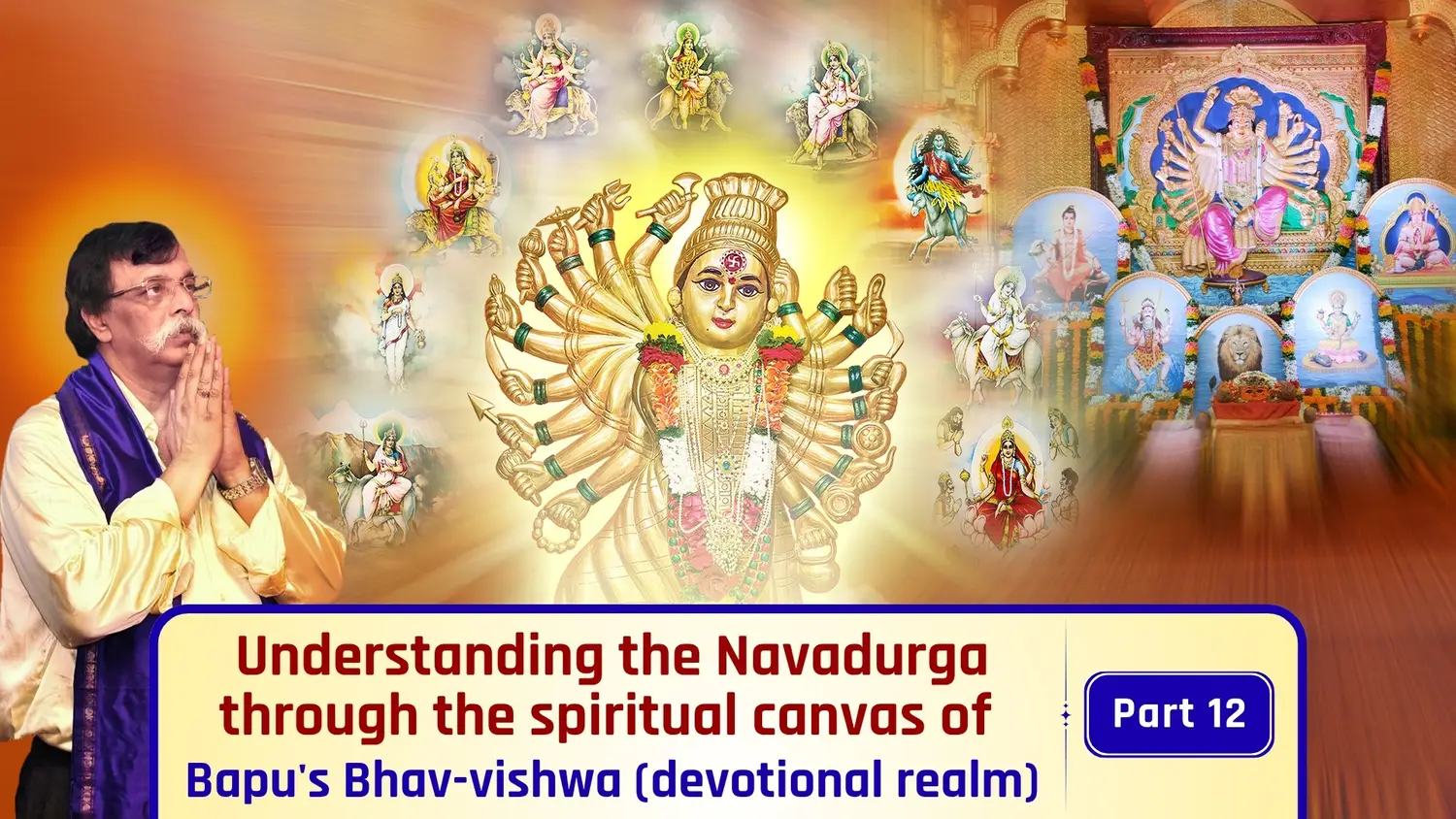
Reference: From the editorials numbered 1402 and 1403 in the Tulsipatra series of the daily ‘Pratyaksha’ by Sadguru Shree Aniruddha Bapu.
In Tulsipatra – 1402, Sadguru Shree Aniruddha Bapu writes:
Brahmavadini Lopamudra bowed her head at the lotus feet of the ninth Navadurga, Siddhidatri—who was standing at eight fingerbreadths above the very ground of Kailash—and then, offering full prostrations to Bhagwan Trivikram and to the Adimata, requested Brahmarshi Yadnyavalkya to speak on her behalf.
With the Adimata’s permission, Brahmarshi Yadnyavalkya stepped forward and began:
“O venerable and noble Shraddhavans present here, I am indebted to the senior Brahmavadini Lopamudra for entrusting me with the task of explaining the next part, for it is because of her that I could witness the journey from Mahagauri to Siddhidatri.
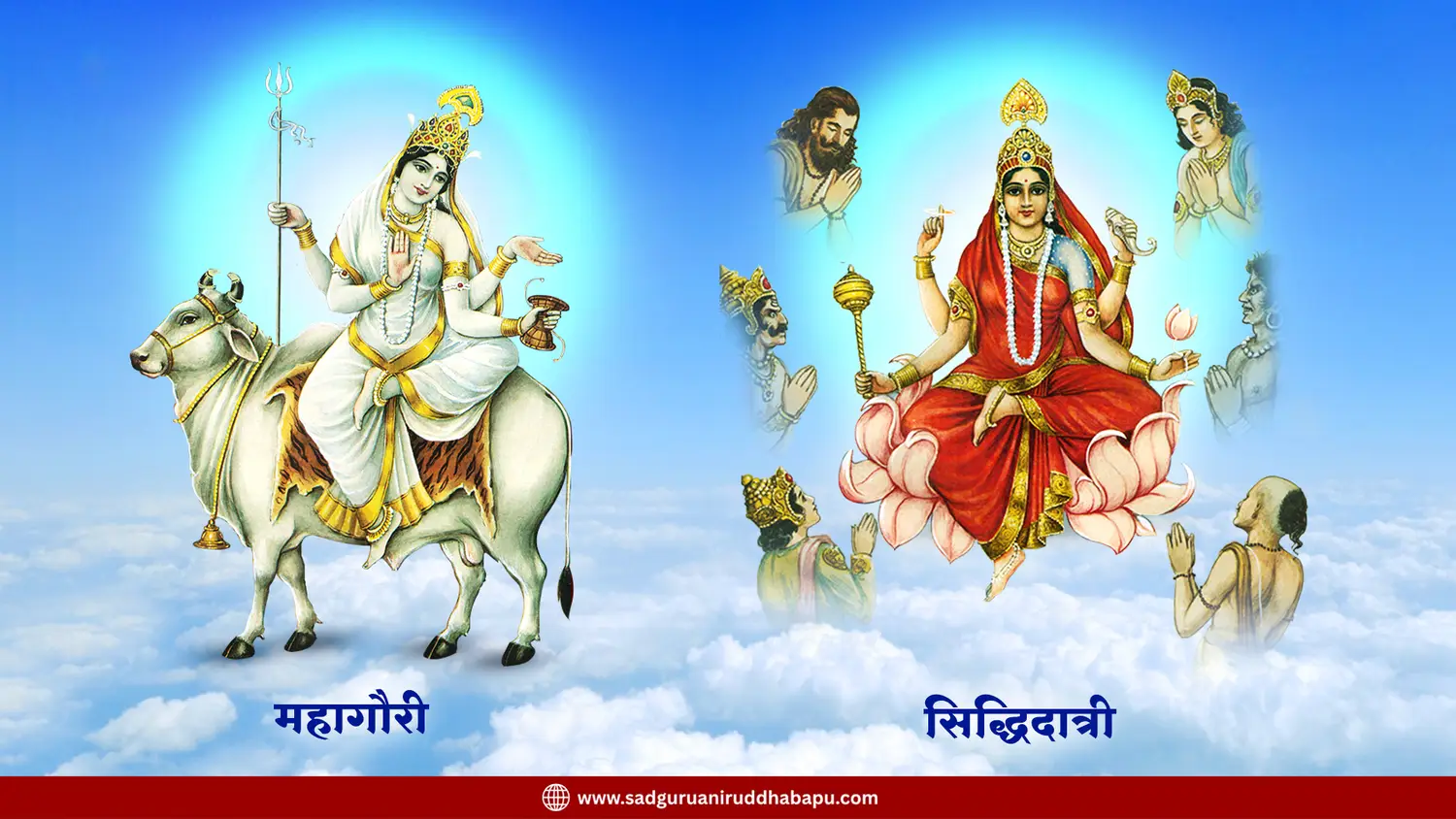
After Parvati, in her form as Mahagauri, gave birth to the Ghanaprana(life force) Ganapati, she naturally became the mother of the life force of the entire universe. In other words, in the form of Mahagauri, this Bhaktamata Parvati became the active force and the force of impact within every type of atom and particle that creates, exists in, and transforms the universe.
Thus, the strength contained in the food or intake (Aahar) a human being eats is she; the Bhakti that man offers, the power within that very Bhakti is also she. Whatever thoughts (Vichar) a person has, the energy within those thoughts is also She (however, 'the energy of bad thoughts' as a concept does not exist; rather, the power of bad thoughts is the absence of Parvati's power). The same holds true for a person’s conduct (Achar) and Vichar (wandering).
Likewise, whatever a person sees with the eyes, hears with the ears, smells with the nose, feels with the skin, and tastes with the tongue, these experiences are stored in the mind as memories.
Yet there are always two categories: pure and impure. The power of a pure fragrance or touch is Parvati’s; the power of an impure smell, taste, or touch is simply the absence of Parvati’s power. Therefore, when a human, using his freedom of action or freewill, keeps doing what is wrong, then Vritrasura is born, sometimes only in his own life, sometimes in the life of society at large.
As ‘Skandamata’ and as ‘Ganeshmata’ (the mother of Ganapati), when this very Parvati became Mahagauri, she enthusiastically began many experiments so that everyone, everywhere, might receive good Dravyashakti (Padarthashakti), power that functions, and Ghanapran (life force of the universe), i.e. the force to act and the force that has impact. Seeing the compassionate work of his beloved consort, Bhagwan ShivShankara was deeply content and joyful, and, inspired by the Adimata, he joined himself to her work. One of the chief inspirations behind the creation of the form ‘Ardha-naarinateshvara’ was this very work of unity.
Thus, when the form of Mahagauri overcame the 'distinct-nondistinct' with Shiva and became one with him, the Adimata bathed that original form of Mahagauri in her radiance and embraced her with immense love, fondness, and motherly affection. At that time, all three of Mahagauri’s sons stood holding to her loose end of her saree(pallu), Ganapati and Skanda at her sides, and the elder son, Virabhadra, behind her and ParamShiva was, of course, united with her.
At the very moment when the Adimata Chandika kissed her daughter’s head with her lips, three principles of the Mother flowed into Parvati—Sarva-shaktisamanvita (सर्वशक्तिसमन्विता-she who is unified with all powers), Sarva-siddhiprasavini (सर्वसिद्धिप्रसविणी-she who gives birth to all siddhis), and Sarva-karankarini (सर्वकारणकारिणी-she who causes all causes). From this, the ninth Navadurga, Siddhidatri, descended, and her unity or oneness was established with the Adimata Chandika’s forms of Mahasiddheshwari, Kalpanarahita, Siddheshwari, Chidagni-kunda-sambhuta, and Lalitambika. Because of this, the ninth stage of Parvati’s life-journey became eternal, and she herself became eternal.
O dear ones present, long before the birth of the Ghanapran Ganapati, I served Lord Shiva as ‘Madhyahna-Nandi’. But when the time came for the birth of Maha-Ganapati, ParamShiva departed for penance with ‘Pratar-Nandi’, and I was kept as the attendant of Parvati.
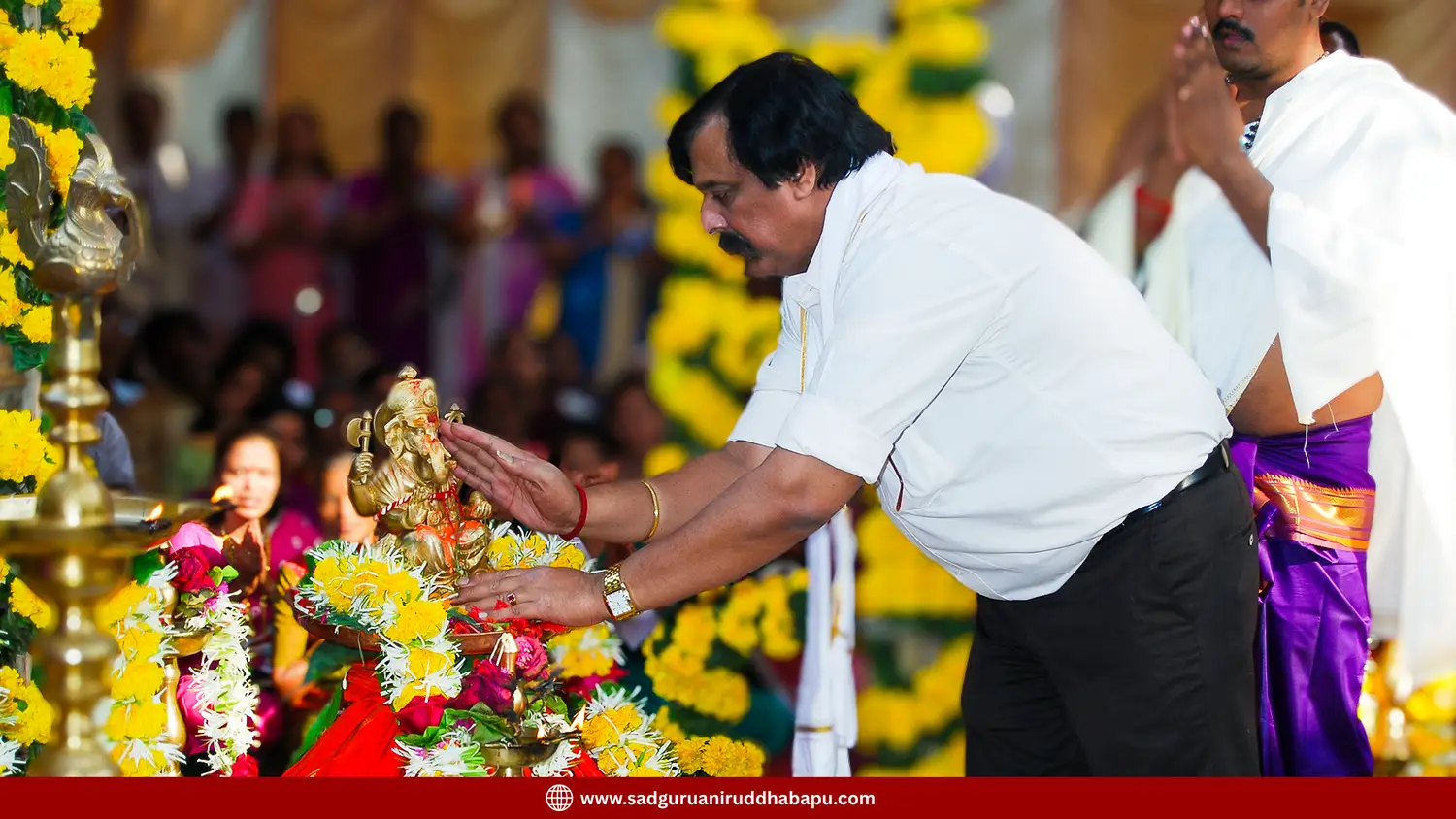
Therefore, after the birth of Maha-Ganapati, when Parvati took up her work, she chose me as her chief associate (Sahakari). She would call me ‘associate,’ though I was truly but an attendant. When Shiva and Parvati, together with their three sons, went to meet the Adimata in solitude in the Manidweep, I too was chosen by them to serve as the vehicle of this Panchayatana of Shiva. Hence I became the only fortunate devotee to witness directly the descent of Siddhidatri.
O devotees, continue, in both Navaratris, to worship with the garland of Navadurga mantras and thereby obtain the grace of the Primordial Mother Chandika, for this Navadurga Siddhidatri always keeps such Shraddhavans in the shelter of her hand of protection. And it is this secret, her hidden work, that I reveal today for the first time to the world of Shraddhavans, with the permission of the God of Gods, Trivikram.”
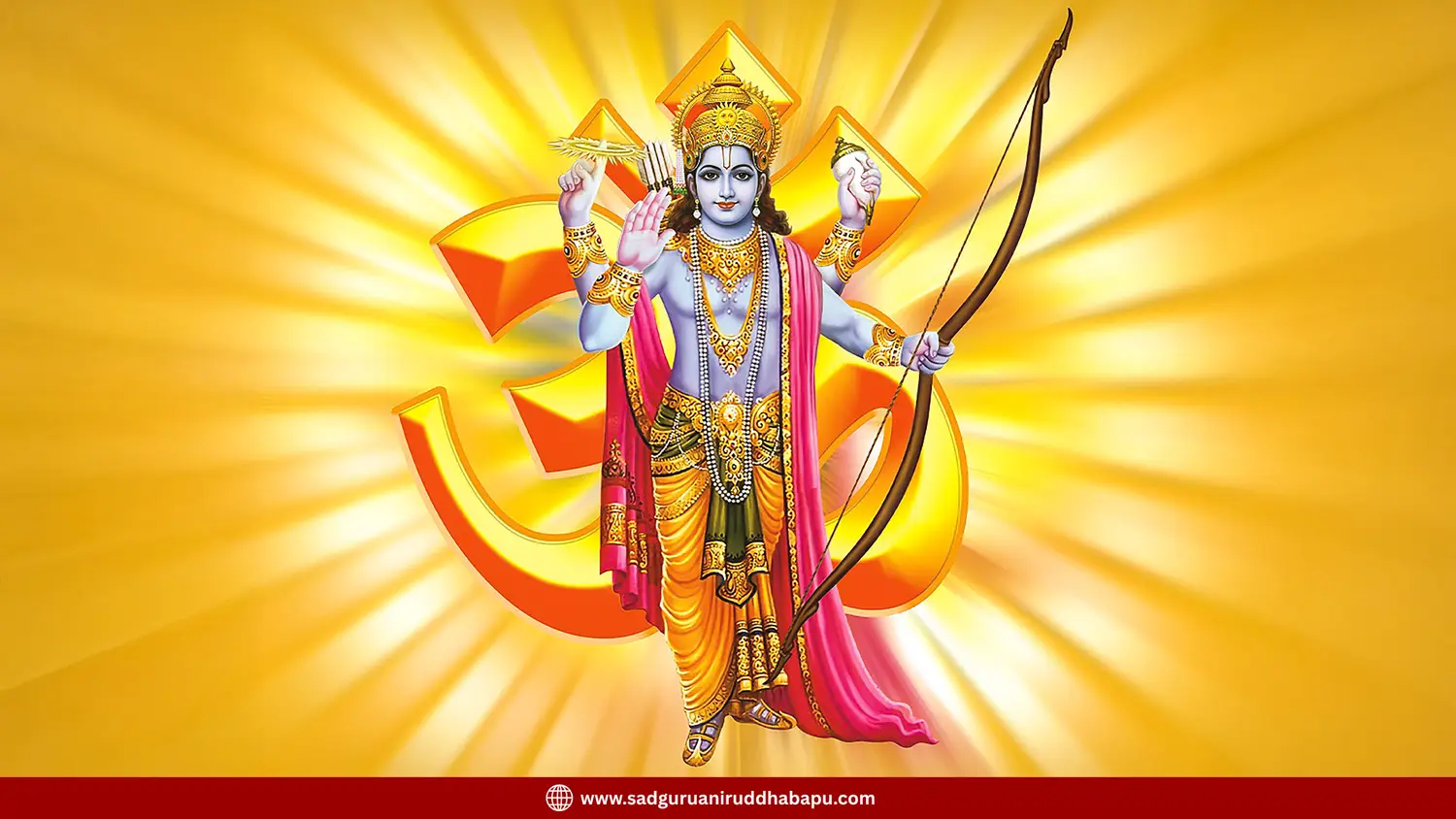
In Tulsipatra – 1403, Sadguru Shree Aniruddha Bapu writes:
After Brahmarshi Yadnyavalkya revealed this beautiful secret, a strong yearning arose among all present to bow their heads at the lotus feet of the ninth Navadurga, Siddhidatri. Yet none dared to come forward with such a request and there was a reason to it. The Adimata herself, along with Bhagwan Trivikram and the other Navadurgas, stood with their feet touching the ground of Kailash. But Siddhidatri alone was the one Navadurga whose feet were eight finger-breadths above the ground of Kailash. Since the mystery behind this remained unknown, it was natural to wonder how one might seek permission.
At last, unable to hold back, Ahalya, the granddaughter of Brahmarshi Agastya and Brahmarshi Kashyapa stepped forward with her husband Brahmarshi Gautama’s permission. With folded hands she asked Brahmarshi Yadnyavalkya: “O eternal Guru, Brahmarshi Yadnyavalkya, we truly wish to bow to all nine Navadurgas. But the first eight Navadurgas standing beside the Adimata have now disappeared into infinity, and at that very time the ninth Navadurga, Siddhidatri, moved forward, holding the golden lotus parasol hovering above the Mother’s head. We all wish to place our heads at her feet. Yet the parasol in her hand is hovering above the Mother’s head, and her own feet are themselves hovering without touching the ground of Kailash. Seeing this, we do not know whether we should ask to touch her feet. Please guide us.”
Looking at Ahalya with great appreciation, Brahmarshi Yadnyavalkya said: “O wise Ahalya, the questions that even Maharshi and Mahamati, superior to you in penance, age, knowledge, and science, did not dare to ask, you have asked with utter ease. Your candid nature and childlike straightforwardness are your true strengths. Listen, Ahalya. After Ganapati’s birth, his work as the Ghanapran was to begin immediately. For this reason, Parvati chose me as Shiva’s messenger, disciple, and vehicle. But as soon as I was chosen, the question of arranging the teaching of Ganapati, who himself is the giver of intellect arose, and I pondered. As always, I went to my elder sister Lopamudra for the answer.
“After hearing all my thoughts, Lopamudra said to me: ‘Do not worry. Even this worry you feel is inspired by the Adimata. For at the very moment Mahagauri entrusts Ganapati to your care for his learning, your worry will vanish naturally because this Ghanapran Ganapati is the true and only wish-fulfilling jewel; and his work as the Chinatami (wish-fulfilling jewel) will begin with you.’
“Assured by Brahmavadini Lopamudra, I accepted the responsibility and became the sole witness to the descent of Siddhidatri. Therefore, I know the inner meaning of how the parasol remains suspended and why Siddhidatri places not even her feet upon the holy Kailash.
“O Ahalya, the sacred work of Siddhidatri continues unceasingly. This form of Parvati is bound neither by time nor by place. The question that troubles sages, seers, and young ascetics, ‘If even the latter part of the era of truth can become burdened by evil thoughts, evil qualities, wrongful deeds, evil enchantments, and demonic tendencies, then what of other eras?’ finds its answer here. The Adimata has shaped this form of Siddhidatri in such a way that she is not bound by place. That is to say, wherever evil rites are performed—by employing 1) wrongful actions, 2) evil desires, 3) evil mantras, 4) the worship of wicked deities, and 5) false knowledge—wherever malicious occult acts intend harm through corrupted powers, the other members of the Chandikakul will never be invited, for inviting them would obstruct the work of those evil people. But Siddhidatri has no restriction on going to or being present at any place.
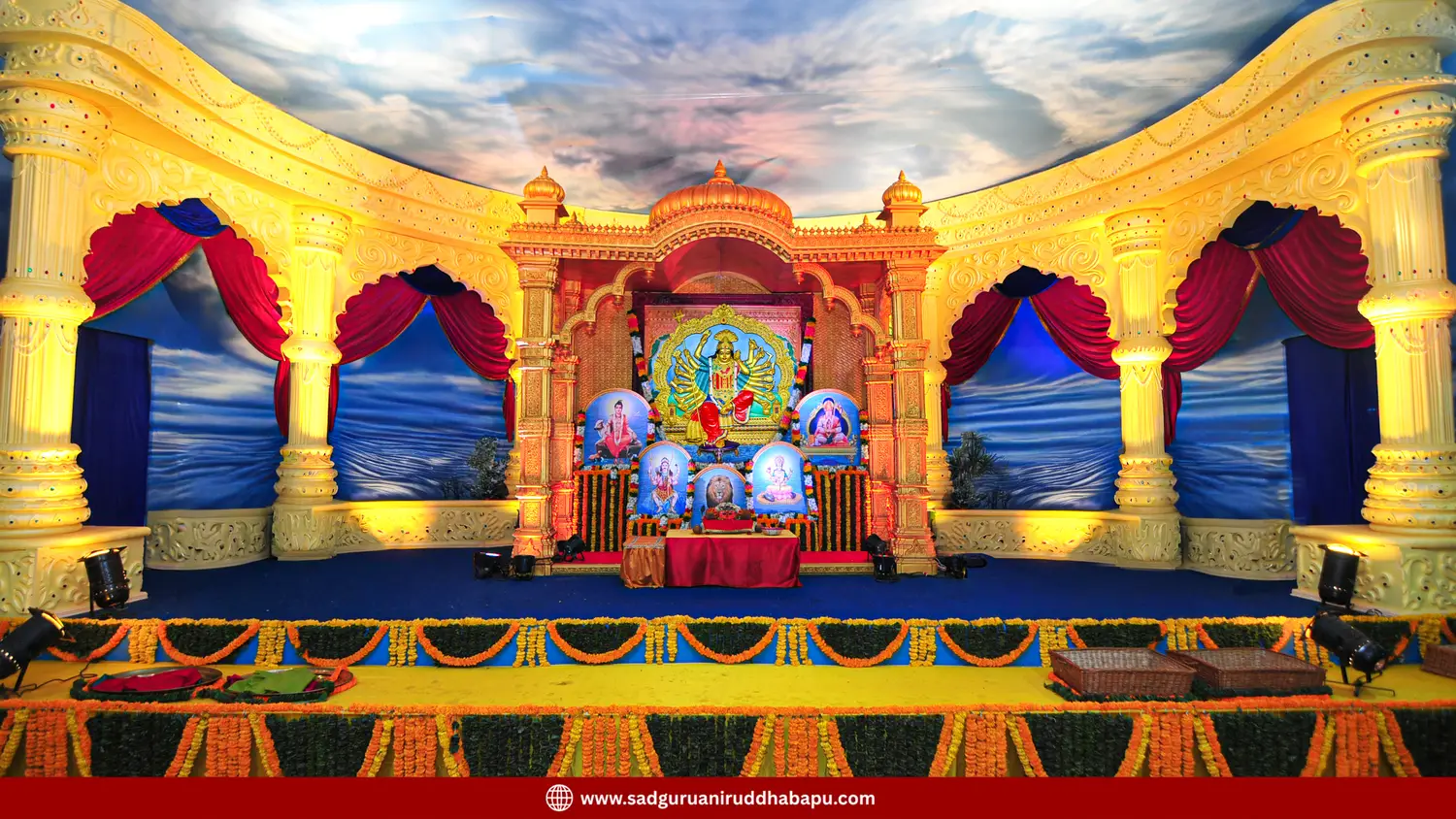
“In truth, the other members of the Chandikakul are not bound either; yet they do not go to evil places without invitation or invocation, lest they impose upon human freedom of action. However, if their devotee is in peril at such a place, then at his very remembrance those members of the Chandikakul manifest there. But Siddhidatri alone, being bound by neither time nor place, is not constrained by freedom of action either, for anyone’s freedom of action depends upon time and place. Therefore this ninth Navadurga, Siddhidatri, stands firmly even in the vilest of places already present from before such wicked processes begin without touching any place, any object, any substance, or any being.
“For what purpose? Siddhidatri leaves any siddhi attained by those on the path opposed to the Chandikakul i.e. the path opposed to the path of the divine, incomplete and flawed. Thus, the protection of devotees continues. She does all of this without touching even the air; for in this work of her effortless protection of devotees, is it not necessary that every act of hers be untouched?
“O Ahalya, you asked of your own accord; therefore the first right to touch her lotus feet is yours, and after you, everyone else’s. Ahalya, offer your obeisance.”
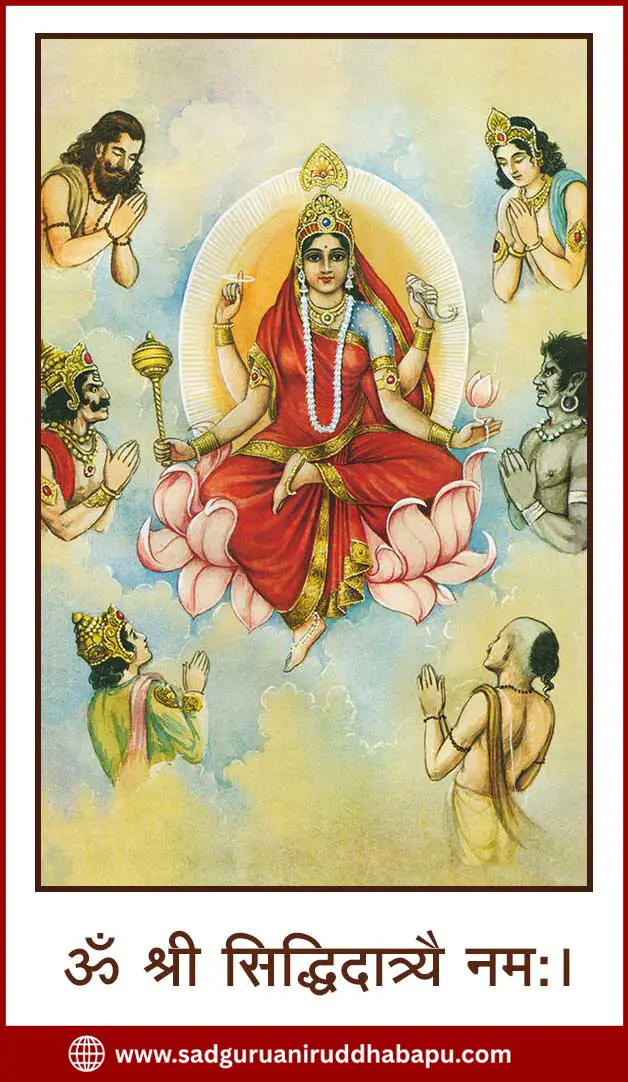
As the Mahamati Ahalya touched the lotus feet of the Navadurga Siddhidatri and placed her head upon them, the Mother Siddhidatri granted her a boon: “Dear daughter Ahalya, your childlike clarity shall ever remain, and through it you shall accomplish great works in every era. The knowledge of the moon (Chandra-vidya) your parents, Shashibhushana and Purnahuti, have already begun to teach you. Use that study to complement the work of your husband, Gautama, who studies the science of the sun. Through this, in the greatest world wars of every era, it is you who shall be the victorious one.”
